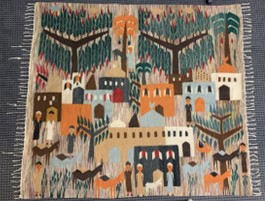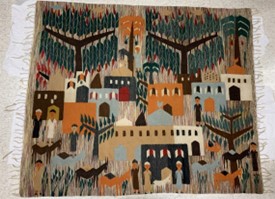This tapestry textile was woven by one of the students of the Wissa Wassef school of Cairo and Harrania, Egypt. This school of handmade textiles was founded in the 1940s and 1950s by the architect Ramses Wissa Wassef, whose aim was to revive and revitalize traditional Egyptian crafts and handiwork by providing local, poor children with training in spinning sheep’s wool and cotton, dying the fibers with plant-based dyes, and weaving, and then encouraging the children to create textile designs using their own imaginations. Wassef believed that youthful enthusiasm, paired with a lack of formal education and the freedom to experiment, would allow unimpaired creativity in the children’s woven art. The children responded to this freedom to create by weaving textiles with brightly colored images of life in their own communities. Over time, the Wissa Wassef school students’ work developed identifiable styles, likely because the students viewed each other’s work and the previous work done at the school, and they were inspired by other students’ themes and creations.
This finely woven Wissa Wassef school textile was likely meant to be a tapestry hung upon a wall. The scene depicted was probably inspired by Harrania or one of the nearby villages, as it includes images of local vernacular architecture, men wearing local traditional clothing and caps, and donkeys, which were commonly used in villages for transportation and as beasts of burden in the mid-20th century. Also depicted are birds, dogs, and a variety of stylized plants and trees, including identifiable palm trees.

Textile with an Islamic Village Scene
by a Wissa Wassef School artist
Islamic Egyptian cultures
20th century
Wool, linen, and pigment
L. 210 x cm W. 5 mm x H. 172 cm
Turner collection #2022.1

Textile with an Islamic Village Scene
by a Wissa Wassef School artist
Islamic Egyptian cultures
20th century
Wool, linen, and pigment
L. 210 x cm W. 5 mm x H. 172 cm
Turner collection #2022.1
For more information, you may contact the researcher(s) noted in the title of this exhibit entry, or Dr. Billie Follensbee, the professor of the course, at BillieFollensbee@MissouriState.edu
